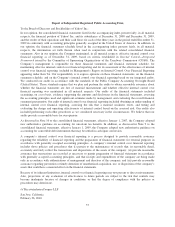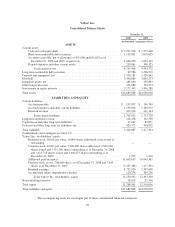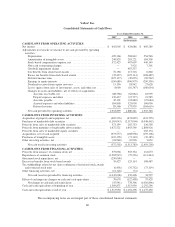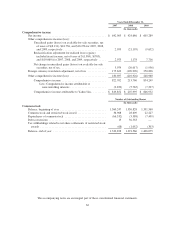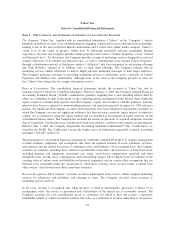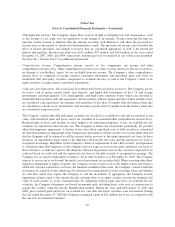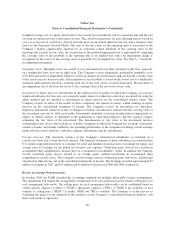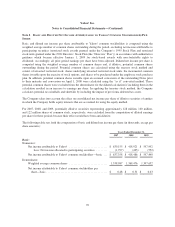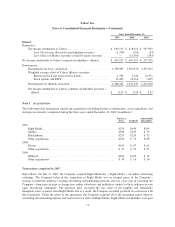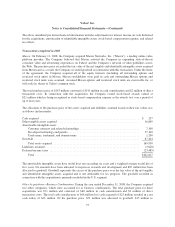Yahoo 2009 Annual Report Download - page 75
Download and view the complete annual report
Please find page 75 of the 2009 Yahoo annual report below. You can navigate through the pages in the report by either clicking on the pages listed below, or by using the keyword search tool below to find specific information within the annual report.Yahoo! Inc.
Notes to Consolidated Financial Statements—(Continued)
with applicable tax laws. The Company adjusts these reserves in light of changing facts and circumstances, such
as the closing of a tax audit, new tax legislation, or the change of an estimate. To the extent that the final tax
outcome of these matters is different than the amounts recorded, such differences will affect the provision for
income taxes in the period in which such determination is made. The provision for income taxes includes the
effect of reserve provisions and changes to reserves that are considered appropriate, as well as the related net
interest and penalties. Income taxes paid were $141 million, $70 million, and $114 million in the years ended
December 31, 2007, 2008, and 2009, respectively. Interest paid was not material in any of the years presented.
See Note 10—“Income Taxes” for additional information.
Comprehensive Income. Comprehensive income consists of two components, net income and other
comprehensive income (loss). Other comprehensive income (loss) refers to gains and losses that are recorded as
an element of stockholders’ equity but are excluded from net income. The Company’s other comprehensive
income (loss) is comprised of foreign currency translation adjustments and unrealized gains and losses on
marketable debt and equity securities categorized as available-for-sale, as well as the Company’s share of its
equity investees’ foreign currency translation adjustments.
Cash and Cash Equivalents, Short and Long-Term Marketable Debt and Equity Securities. The Company invests
its excess cash in money market funds, time deposits, and liquid debt instruments of the U.S. and foreign
governments and their agencies, U.S. municipalities, and high-credit corporate issuers which are classified as
marketable debt securities and cash equivalents. All investments with an original maturity of three months or less
are considered cash equivalents. Investments with maturities of less than 12 months from the balance sheet date
are classified as current assets. Investments with maturities greater than 12 months from the balance sheet date
are classified as long-term assets.
The Company’s marketable debt and equity securities are classified as available-for-sale and are reported at fair
value, with unrealized gains and losses, net of tax, recorded in accumulated other comprehensive income (loss).
Realized gains or losses and declines in value judged to be other-than-temporary, if any, on available-for-sale
securities are reported in other income, net. The Company evaluates the investments periodically for possible
other-than-temporary impairment. A decline of fair value below amortized costs of debt securities is considered
an other-than-temporary impairment if the Company has the intent to sell the security or it is more likely than not
that the Company will be required to sell the security before recovery of the entire amortized cost basis. In those
instances, an impairment charge equal to the difference between the fair value and the amortized cost basis is
recognized in earnings. Regardless of the Company’s intent or requirement to sell a debt security, an impairment
is considered other-than-temporary if the Company does not expect to recover the entire amortized cost basis; in
those instances, a credit loss equal to the difference between the present value of the cash flows expected to be
collected based on credit risk and the amortized cost basis of the debt security is recognized in earnings. The
Company has no current requirement or intent to sell its debt securities as of December 31, 2009. The Company
expects to recover up to (or beyond) the initial cost of investment for securities held. When assessing other-than-
temporary impairment of equity securities, the Company reviews factors such as the length of time and extent to
which fair value has been below cost basis, the financial condition of the issuer, the Company’s intent to hold the
investment for a period of time which may be sufficient for an anticipated recovery in market value, and whether
its cash flow needs may require the Company to sell the investment. If appropriate, the Company records
impairment charges equal to the amount that the carrying value of an equity security exceeds the estimated fair
value of such security as of the evaluation date. In computing realized gains and losses on available-for-sale
securities, the Company determines cost based on amounts paid, including direct costs such as commissions to
acquire the security, using the specific identification method. During the years ended December 31, 2007 and
2008, gross realized gains and losses on available-for -sale debt and equity securities were not material. During
the year ended December 31, 2009 the Company recognized a gain of $42 million, net of tax, in connection with
the sale of its investment in Gmarket.
67


